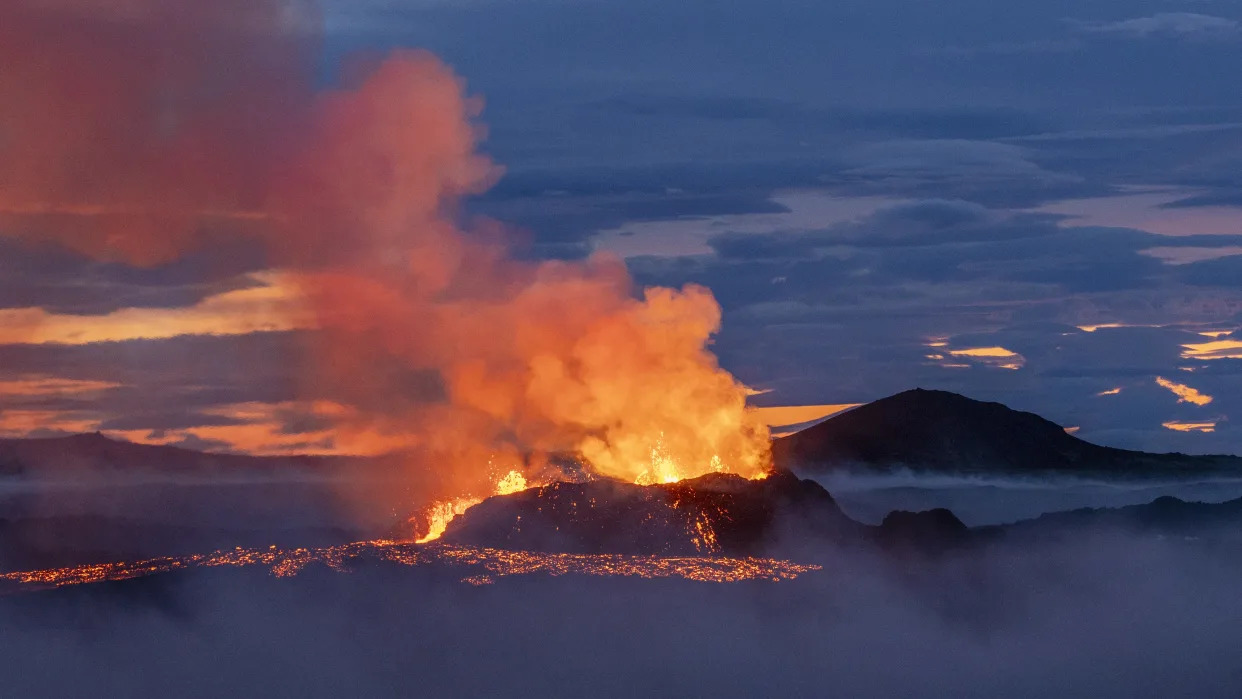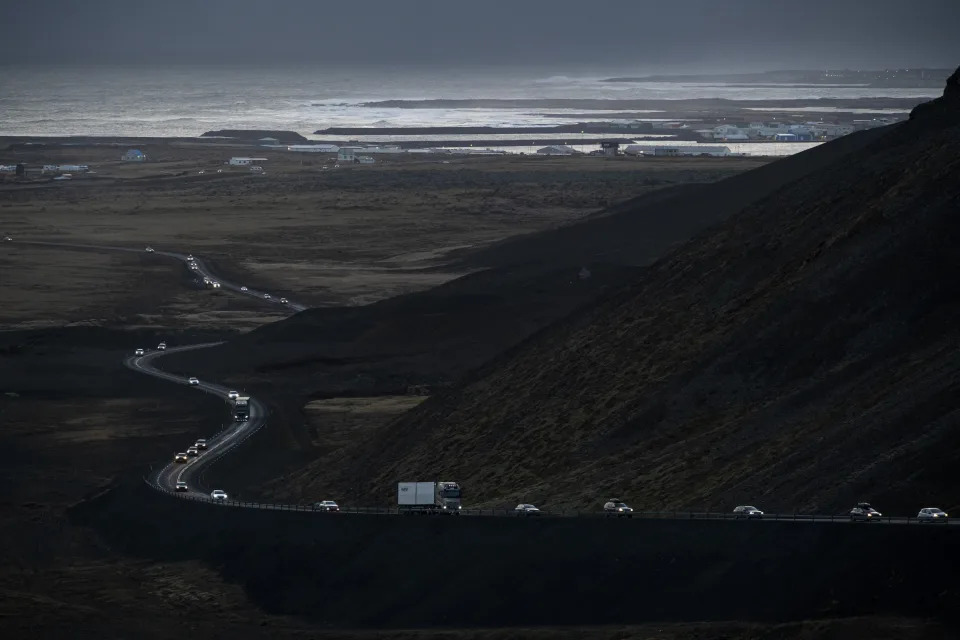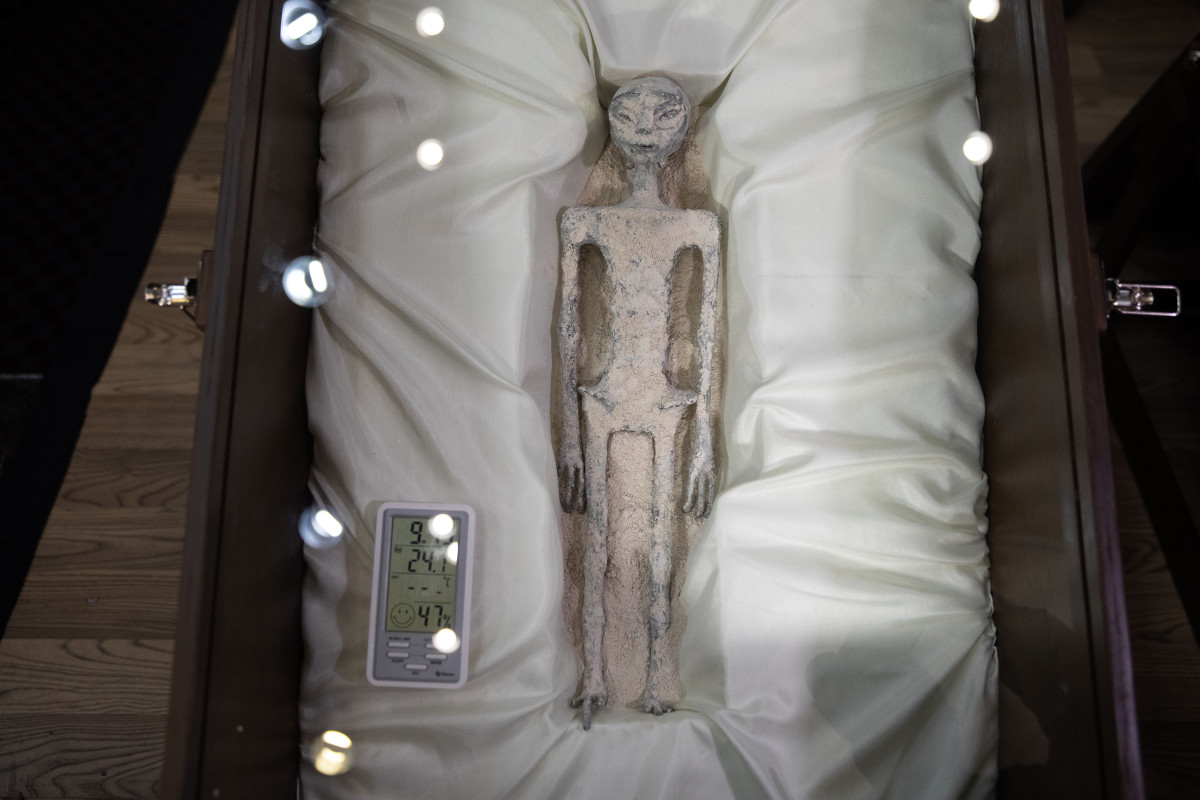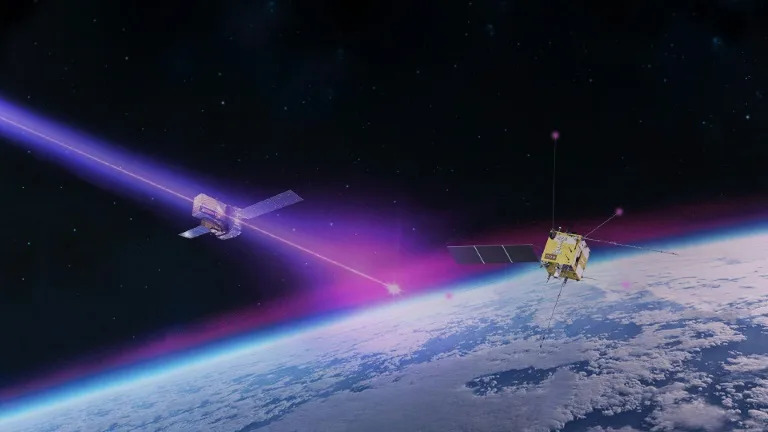Hannah Osborne
Tue, November 14, 2023

Fagradalsfjall volcano in Iceland erupting at dusk
Iceland's potentially imminent eruption in the Reykjanes Peninsula is part of a 1,000-year cycle of volcanic activity that will likely cause eruptions for centuries, scientists say.
"Time's finally up," Edward W. Marshall, a researcher at the University of Iceland's Nordic Volcanological Center, told Live Science in an email. "We can get ready for another few hundred years of eruptions on the Reykjanes."
Seismic activity began increasing in the south of the peninsula in October, with hundreds of earthquakes recorded there each day. On Nov. 10, authorities evacuated the town of Grindavík, with experts warning an volcanic eruption could take place in just days.

Infographic showing the seismic activity that has hit Iceland in recent weeks
According to the Icelandic Met Office (IMO), a magma tunnel stretching 9.3 miles (15 kilometers) formed beneath the ground between Sundhnúkur in the north and Grindavík. The area affected also encompasses the Blue Lagoon geothermal spa — a tourist hotspot that attracts hundreds of thousands of visitors annually.
That 2021 eruption marked the start of a new cycle of volcanic activity on the Reykjanes Peninsula. Geological records show periods of inactivity last between 600 and 1,200 years, which is then followed by pulses of eruptions lasting between 200 and 500 years, Clive Oppenheimer, a professor of volcanology at the University of Cambridge in the U.K., told Live Science in an email.
"It looks like 2021 kicked off a new eruptive phase which might see the several fault zones crossing the [Reykjanes Peninsula] firing on and off for centuries," he said.

vehicles leaving the town of Grindavik, southwestern Iceland, during evacuation following earthquakes., with the sea in the background
The Reykjanes Peninsula sits above two tectonic plates that are being pulled apart. The strain that builds up is released in bursts as part of the cycle. "We are now in one of these pulses," David Pyle, a volcanologist and professor of Earth sciences at the University of Oxford, U.K, told Live Science in an email. "Each eruption releases just a bit more of the stored-up strain, and eventually, when all of that strain has been released, then the eruptions will stop."
It is currently unclear if an eruption will take place as a result of the magma tunnel. "These sorts of dikes are actually a tectonic, not a magmatic feature. In other words, the lava is filling a fracture, not forcing its way into the rock," Marshall said.
Should a fissure emerge, an eruption could last for several weeks. The large amount of magma involved compared with previous eruptions in the region could result in more lava flow at the surface, Oppenheimer said.
What happens next is a waiting game, Marshall said. "I predict — if an eruption occurs — that it will occur between a few days to threeish weeks. If it hasn't erupted in three weeks, I don't think it will happen. Cooling will begin to close the fractures."
Related:
—California's supervolcano has a massive lid that causes swarms of earthquakes — and that's a good thing, scientists say
—Perilous expedition to uninhabited island in South Atlantic confirms existence of world's 8th lava lake
—Volcanoes like Kīlauea and Mauna Loa don't erupt like we thought they did, scientists discover
Where is the largest active volcano in the world?
Emilee Speck
Tue, November 14, 2023

Hawaii's Mauna Loa is the largest active volcano on Earth, with the summit more than 10 miles above its base, according to the U.S. Geological Survey.
Located inside Hawai'i Volcanoes National Park, Mauna Loa makes up more than half of the Big Island, standing at 13,681 feet above sea level, according to the National Park.
About 30,000 feet of Mauna Loa starts from the bottom of the sea, about 1,000 feet taller than Mount Everest, the planet's highest mountain above sea level.
WHAT ARE THE 4 CLASSIC TYPES OF VOLCANOES?
Hawaii's Mauna Kea volcano is taller at 33,500 feet. However, Mauna Loa is much larger by volume, according to the USGS.

Map notes the locations of Mauna Loa, along with nearby sister volcano Kilauea.
Mauna Loa is so massive that the sea floor caves in another 5 miles from the weight of the volcano.
Including the most recent eruption in November 2022, Mauna Loa has erupted 34 times since its first well-documented eruption in 1843, according to the USGS Hawaiian Volcano Observatory.
The 12-day eruption in 2022 marked the first since 1984.
About two months before its last eruption, Mauna Loa began displaying increased seismic activity, one of the signs geologists look for when an eruption is imminent.
WHAT HAPPENS BEFORE A VOLCANO ERUPTS?
Since its 2022 eruption, Mauna Loa has been mostly quiet, according to the Hawaii Volcano Observatory, but remains active with increasing seismic activity as recently as October.
Only about 20 miles from Mauna Loa, Kīlauea is Hawaii's second-largest active volcano and most recently erupted in September.
Mauna Loa and Kīlauea are classic examples of shield volcanoes and are among the most active in the world.
This type of volcano is typically the largest on Earth and covers a broad swath of terrain.
Volcanologists say the great width of these volcanoes is a result of thin lava flows. Eruptions are not considered to be eruptive and usually rank low on the VEI. Threats from landslides and volcanic smog are usually significant for these types of volcanoes.
Original article source: Where is the largest active volcano in the world?
Can one volcano's eruption trigger an eruption at another volcano?
Emilee Speck
Mon, November 13, 2023

According to the U.S. Geological Survey, it is difficult to determine if one eruption caused another.
Active volcanic regions, such as the Rabaul Caldera in Papua New Guinea and Iceland's Reykjanes volcanic region, sometimes have common magma reservoirs that can trigger unrest.
WHAT HAPPENS BEFORE A VOLCANO ERUPTS?
According to the USGS, the largest volcano eruption in the 20th century happened in 1912 when Alaska’s Novarupta volcano began spewing magma that came from a reservoir 6 miles away beneath Mount Katmai. Even though it was the source of the magma, Mount Katmai did not erupt.
There are also volcanoes near one another that do not share this magma system, like Hawaii's Kilauea volcano, only 20 miles from Mauna Loa, but the two have individual magma reservoirs, according to the USGS.
There are multiple ongoing active eruptions worldwide at one time, and between 60 and 70 eruptions a year.
Most recently, officials warned of an impending volcanic eruption in Grindavík, Iceland, where the town has been evacuated following thousands of earthquakes. At the same time, Italy's Mount Etna began spewing lava fountains in the sky in November, just months after its August eruption.
However, according to the USGS, no definitive evidence exists that one eruption can trigger another eruption from a different volcano system that is hundreds of miles away or even on a different continent.
WHAT ARE THE 4 CLASSIC TYPES OF VOLCANOES?
There are signs of an impending eruption, including earthquakes, ground deformation and changes in gas emissions. Still, geology experts say predicting an eruption is not an exact science.
There are some historical examples of simultaneous eruptions within about 6 miles, but the USGS said it's unclear if one eruption caused the other.
Russia's tallest volcano spews out 1,000-mile-long river of smoke after giant eruption, satellite images reveal
Harry Baker
Tue, November 14, 2023

A dark cloud of smoke flows from a lava flow on a volcano
Eurasia's tallest volcano has violently erupted, throwing a 1,000-mile-long (1,600 kilometers) cloud of dust and ash into the air, new NASA satellite images show.
Klyuchevskoy, sometimes referred to as Klyuchevskaya Sopka, is an active stratovolcano in Russia's Kamchatka Peninsula, which is home to more than 300 other volcanos. Klyuchevskoy's peak stands at 15,584 feet (4,750 meters) above sea level, making it taller than any other volcano in Asia or Europe, according to the Kamchatka Volcanic Eruption Response Team (KVERT).
Klyuchevskoy has been continually erupting since mid-June. But on Nov. 1, a massive volcanic explosion released a torrent of smoke and ash, which reached a maximum height of 7.5 miles (12 km) above Earth's surface, according to NASA's Earth Observatory.
The smoke and ash plume prompted KVERT to temporarily raise the aviation alert level to red (the highest possible level), which grounded planes in the area. Several schools were also evacuated due to the increase in air pollution.
The Landsat 8 satellite, which is co-run by NASA and the U.S. Geological Survey, captured a striking false-color image of the eruption plume (shown above), in which the red lava plume and grey smoke stand out against the surrounding blue-colored clouds.
NASA's Aqua satellite also captured a wider true-color image of the plume (shown below), which shows that the river of smoke was around 1,000 miles long at the time. But the plume may have eventually stretched up to 1,400 miles (2,255 km) long, according to the Smithsonian Institution's Global Volcanism Program.
Related: The 12 biggest volcanic eruptions in recorded history
The outburst only lasted for a few days, and it now appears that Klyuchevskoy may have stopped erupting altogether, according to KVERT.
The Kamchatka Peninsula is part of the Pacific Ring of Fire — a 25,000-mile-long (40,200 km) tectonic belt that circumscribes the Pacific Ocean and contains around three-quarters of the world's active volcanos.
The Ring of Fire has also recently been active in other areas: On Oct. 30, an underwater volcanic eruption off the coast of the Japanese island Iwo Jima birthed a brand new tiny island of hardened magma, which can also be seen from space.

A satellite image of a large eruption plume stretching across Russia and the Pacific Ocean
While the trail of smoke and ash given off by Klyuchevskoy was enormous, it is still quite a way off some of the largest eruption plumes ever seen.
The tallest eruption plume in recorded history was the towering pillar of smoke, ash and water vapor from the eruption of Tonga's underwater volcano in January 2022, which rose to 35.4 miles (57 km) above sea level.
related stories
—Astronaut captures image of a glowering 'skull' lurking in a giant volcanic pit in the Sahara
—One of the world's most active volcanoes is spewing out weird rings of smoke
—Massive ancient lava flow seen from space looks like a giant black scar on the New Mexico desert
Following the Tonga eruption, scientists warned that the record amount of water vapor it released into the stratosphere could weaken the ozone layer. And in September this year, scientists partially attributed the eruption as the cause of an unusually large ozone hole above Antarctica.
However, Klyuchevskoy's latest eruption plume will likely have no real impact on the ozone layer because it contained much less water vapor and did not reach as high up in the atmosphere.



















